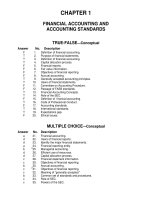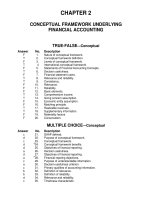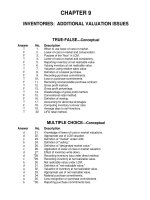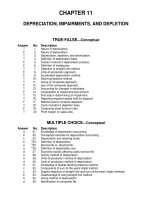Intermediate accounting 16e by kieso slide ch22
Bạn đang xem bản rút gọn của tài liệu. Xem và tải ngay bản đầy đủ của tài liệu tại đây (1.84 MB, 78 trang )
22-1
PREVIEW OF CHAPTER 22
22-2
Intermediate Accounting
16th Edition
Kieso ● Weygandt ● Warfield
22
Accounting Changes
and Error Analysis
LEARNING OBJECTIVES
After studying this chapter, you should be able to:
1 Identify types of accounting
changes and understand the
accounting for changes in
accounting principles.
3 Describe the accounting for
correction of errors.
4 Analyze the effect of errors.
2 Describe the accounting for
changes in estimates and
changes in the reporting entity.
22-3
LO 1
ACCOUNTING CHANGES
Accounting Alternatives:
Diminish the comparability of financial information.
Obscure useful historical trend data.
Types of Accounting Changes:
1. Change in Accounting Policy.
2. Changes in Accounting Estimate.
3. Change in Reporting Entity.
Errors are not considered an accounting change.
22-4
LO 1
Changes in Accounting Principle
Change from one accepted accounting policy to another.
Examples include:
Average cost to LIFO.
Completed-contract to percentage-of-completion method.
Adoption of a new principle in recognition of events that have occurred
for the first time or that were previously immaterial is not an accounting
change.
22-5
LO 1
Changes in Accounting Principle
Three approaches for reporting changes:
1) Currently.
2) Retrospectively.
3) Prospectively (in the future).
FASB requires use of the retrospective approach.
Rationale - Users can then better compare results from one period to
the next.
22-6
LO 1
WHAT DO THE NUMBERS MEAN?
QUITE
A CHANGE
WHAT’S YOUR
PRINCIPLE
The cumulative-effect approach results in a loss of comparability. Also,
reporting the cumulative adjustment in the period of the change can
significantly affect net income, resulting in a misleading income fi example, at
one time Chrysler Corporation changed its inventory accounting from LIFO to
FIFO. If Chrysler had used the cumulative-effect approach, it would have
reported a $53,500,000 adjustment to net income. That adjustment would have
resulted in net income of $45,900,000, instead of a net loss of $7,600,000.
A second case: In the early 1980s, the railroad industry switched from the
retirement-replacement method of depreciating railroad equipment to more
generally used methods such as straight-line depreciation. Using cumulative
treatment, railroad companies would have made substantial adjustments to
income in the period of change. Many in the industry argued that including
such large cumulative-effect adjustments in the current year would distort the
information and make it less useful. Such situations lend support to
retrospective application so that comparability is maintained.
22-7
LO 1
Changes in Accounting Principle
Retrospective Accounting Change Approach
Company reporting the change
1) Adjusts its financial statements for each prior period
presented to the same basis as the new accounting
principle.
2) Adjusts the carrying amounts of assets and liabilities as
of the beginning of the first year presented, plus the
opening balance of retained earnings.
22-8
LO 1
Changes in Accounting Principle
Retrospective Accounting Change: Long-Term
Contracts
Illustration: Denson Company has accounted for its income from
long-term construction contracts using the completed-contract
method. In 2017, the company changed to the percentage-ofcompletion method. Management believes this approach provides
a more appropriate measure of the income earned. For tax
purposes, the company uses the completed-contract method and
plans to continue doing so in the future. (Assume a 40 percent
enacted tax rate.)
22-9
LO 1
22-10
ILLUSTRATION 22-1
Comparative Income Statements for Completed-Contract versus Percentage-of-Completion Methods
LO 1
Changes in Accounting Principle
Data for Retrospective Change
ILLUSTRATION 22-2
Journal entry
beginning of
2017
22-11
Construction in Process
Deferred Tax Liability
Retained Earnings
220,000
88,000
132,000
LO 1
WHAT DO THE NUMBERS MEAN?
CHANGE
WHAT’S
YOUR MANAGEMENT
PRINCIPLE
Halliburton offers a case study in the importance of good reporting of an
accounting change. Note that Halliburton uses percentage-of-completion
accounting for its long-term construction-services contracts. The SEC
questioned the company about its change in accounting for disputed claims.
Prior to the year of the change, Halliburton took a very conservative approach
to its accounting for disputed claims. That is, the company waited until all
disputes were resolved before recognizing associated revenues. In contrast, in
the year of the change, the company recognized revenue for disputed claims
before their resolution, using estimates of amounts expected to be recovered.
Such revenue and its related profit are more tentative and subject to possible
later adjustment. The accounting method adopted is more aggressive than the
company’s former policy but is within the boundaries of GAAP. It appears that
the problem with Halliburton’s accounting stems more from how the company
handled its accounting change than from the new method itself. That is,
Halliburton did not provide in its annual report in the year of the change an
explicit reference to its change in accounting method.
22-12
LO 1
WHAT DO THE NUMBERS MEAN?
CHANGE
WHAT’S
YOUR MANAGEMENT
PRINCIPLE
In fact, rather than stating its new policy, the company simply deleted the
sentence that described how it accounted for disputed claims. Then later, in its
next year’s annual report, the company stated its new accounting policy.
Similar transparency concerns have been raised when companies, like
Hawthorn Bancshares, did not provide sufficient explanation about their
changes to fair value accounting for their mortgage servicing rights. When
companies make such changes in accounting, investors need to be informed
about the change and about its effects on the financial results. With such
information, investors and analysts can compare current results with those of
prior periods and can make a more informed assessment about the company’s
future prospects.
Sources: Adapted from “Accounting Ace Charles Mulford Answers Accounting Questions,” Wall
Street Journal Online (June 7, 2002); and J. Arnold, B. Blisard, and J. Duggan, “Dealing with the
Implications of Accounting Change,” FEI Magazine (November 2012).
22-13
LO 1
Changes in Accounting Principle
Reporting a Change in Principle
Major disclosure requirements are as follows.
22-14
1.
Nature of the change in accounting principle.
2.
The method of applying the change, and:
a.
A description of the prior period information that has been
retrospectively adjusted, if any.
b.
The effect of the change on income from continuing operations,
net income (or other appropriate captions of changes in net assets
or performance indicators), any other affected line item.
c.
The cumulative effect of the change on retained earnings or other
components of equity or net assets in the balance sheet as of the
beginning of the earliest period presented.
LO 1
ILLUSTRATION 22-3
Comparative Information Related to Accounting Change (Percentage-of-Completion)
22-15
LO 1
Changes in Accounting Principle
Retained Earnings Adjustment
Retained earnings balance is $1,360,000 at the beginning of 2015.
ILLUSTRATION 22-4
Before Change
22-16
LO 1
Changes in Accounting Principle
Retained Earnings Adjustment
Illustration 22-5
22-17
After Change
LO 1
Changes in Accounting Principle
Illustration (Change in Principle—Long-Term Contracts): Pam
Erickson Construction Company changed from the completed-contract
to the percentage-of-completion method of accounting for long-term
construction contracts during 2018. For tax purposes, the company
employs the completed-contract method and will continue this
approach in the future. (Hint: Adjust all tax consequences through the
Deferred Tax Liability account.)
22-18
LO 1
Changes in Accounting Principle
Illustration (Change in Principle—Long-Term Contracts):
Instructions: (assume a tax rate of 35%)
(a) What entry(ies) are necessary to adjust the accounting records
for the change in accounting principle?
(b) What is the amount of net income and retained earnings that
would be reported in 2018? Assume beginning retained earnings
for 2017 to be $100,000.
22-19
LO 1
Changes in Accounting Principle
Illustration: Pre-Tax Income from Long-Term Contracts
Journal entry (recorded in 2018)
Construction in Process 190,000
Deferred Tax Liability
Retained Earnings
22-20
66,500
123,500
LO 1
Changes in Accounting Principle
Illustration: Comparative Statements
Income
Statement
Statement
of Retained
Earnings
22-21
LO 1
Changes in Accounting Principle
Direct and Indirect Effects of Changes
22-22
Direct Effects - FASB takes the position that
companies should retrospectively apply the direct
effects of a change in accounting principle.
Indirect Effect is any change to current or future
cash flows of a company that result from making a
change in accounting principle that is applied
retrospectively.
LO 1
Changes in Accounting Principle
Impracticability
Companies should not use retrospective application if one of the
following conditions exists:
1.
Company cannot determine the effects of the retrospective
application.
2.
Retrospective application requires assumptions about
management’s intent in a prior period.
3.
Retrospective application requires significant estimates that
the company cannot develop.
If any of the above conditions exists, the company prospectively applies the
new accounting principle.
22-23
LO 1
22
Accounting Changes
and Error Analysis
LEARNING OBJECTIVES
After studying this chapter, you should be able to:
1 Identify types of accounting
changes and understand the
accounting for changes in
accounting principles.
3 Describe the accounting for
correction of errors.
4 Analyze the effect of errors.
2 Describe the accounting for
changes in estimates and
changes in the reporting entity.
22-24
LO 2
Changes in Accounting Estimate
Examples of Estimates
1. Uncollectible receivables.
2. Inventory obsolescence.
3. Useful lives and salvage values of assets.
4. Periods benefited by deferred costs.
5. Liabilities for warranty costs and income taxes.
6. Recoverable mineral reserves.
7. Change in depreciation methods.
22-25
LO 2









